For our one week stay in France we made reservations on an overnight ferry and at three different places to stay. Our plan was to use public transportation, buses, trains, taxis and subways, for each move. When we got off the Dawn from our cruise we took the shuttle to Heathrow where we could leave our big suitcase while we were touring in France. Even though the ferry we were taking out of Portsmouth was less than twenty miles from where we got off the Dawn and Heathrow airport was over 60 miles the other way, our bag would be where we were our return flight to Pittsburgh departed. From Heathrow we took a train and the underground to Waterloo, 20 miles into London. From there it was over 70 miles by train to Portsmouth.
All that travel took awhile but we still had a long wait for the overnight ferry that did not leave until almost 11:00 PM. When we checked in they told us there was a pub just around the corner.
The cabin was small with bunk beds, toilet and shower but it was nicer than we were expecting. It did not really matter as we went to straight to bed.
It was still dark when we got off the ferry in France the following morning so we found a restaurant and had breakfast. We then walked to the bus stop to wait for the bus to take the 10 mile ride to the train station in Caen. From there it was a 20 mile train ride to Bayeux where we were staying for three nights.
We were staying at Chez Titi, a place I found on Bookings. The apartment was on the third floor up this spiral staircase.
It was a neat little place with kitchen, living room and bath on one floor. The bed was up another spiral staircase in a loft. It was nice being able to make coffee and buy pastries for breakfast from a local shop.
The view from the apartment. Bayeux was a very neat town with many old buildings. It was the only city in Normandy that was not damaged during WWII.
This old Norman building is an example of the wonderful architecture.
The old cobblestone streets. In the evening some streets were closed to vehicle traffic and opened to diners.
The Bayeux Tapestry is a 70 meter long embroidery that tells the story of the 1066 conquest of England by William, Duke of Normandy. William is know today as William the Conqueror. This portion shows the crossing of the channel in long boats.
There are 58 different scenes, 626 characters and 202 horses in the work. This one shows the cooks preparing a meal. The tapestry is a great way to learn a bit of history. Earphones are available in several different languages. Here is a link to where you can see the entire work.
The site of Notre- Dame Cathedral Bayeux was consecrated in 1077 by Bishop Odin de Conteville in the presence of his brother William the Conqueror. The church was started in the Romanesque style and later changed to Gothic.
The Gothic style with the high narrow nave and arched ceiling. This is very different than the thick walls of the Romanesque style.
The thinner walls let in more light and lead to stained glass windows. Since we did not get to Notre-Dame Paris this one had to do.
We had two major tours we wanted to do in Normandy. The first was the World War II D-Day beaches. The invasion, called Operation Overlord, took months to plan the largest amphibious assault in history.
Our guide Igor started the tour with a map that showed the area of the invasion. The landing area stretched nearly 50 miles along the Normandy coast.
There were five target beaches code named Utah and Omaha, American forces; Gold, British; Juno, Canadian and Sword, British.
While D-Day was June 6, 1944,, the attack began the night before with paratroopers and gliders bringing men and supplies into France. Sainte-Mere-Eglise was occupied by the Germans but some troops where dropped there by mistake. Look closely and you can see the effigy of Paratrooper John Steele hanging on the side of the church where his parachute got stuck. He was released from his harness by a German solder and taken prisoner, but later escaped and rejoined his company.
The church has two stained glass windows that honor the paratroops. This one "they have returned" was unveiled on the 25th anniversary of D-Day in 1969. The AA honors the 82 Airborne's 505th Parachute Infantry Regiment.
This widow shows the Virgin Mary and baby Jesus with three paratroopers and many more chutes in the background.
A monument honoring the 82nd and 101st Airborne who liberated the town, Sainte-Mere-Eglise, from Nazi Germany. It was not just at the tourist attractions that fly the American flag. Many homes and businesses had both the French and American flags showing their appreciation for the sacrifice of the American solders.
The story of this home on D-Day is that the owner was in her garden and a paratrooper landed beside her. She thought it was an angel from Heaven coming to help her.
If you read anything about D-Day the hedge rows that surrounded the farmers land were a major problem for the troops. In some cases gliders crashed into them killing the pilots and soldiers. Once the ground fighting began, there was a very limited line of sight. The roads we traveled on the tour were very narrow but this lane is what they would have encountered on D-Day.
Utah Beach was the first beach stormed by Allied forces. It was nearest to Cherbourg, that had a deep water port. The invasion started at low tide so the German defenses would be exposed and so the landing craft would be lifted by the incoming tide and not get stuck on the beach. By the end of the day 23,000 American troops had landed here.
The military engineers played a major role in the landing, finding and destroying the hedgehogs and other defenses the Germans had in place. This opened the path for the landing craft to come ashore.
In addition to soldiers, thousands of pieces of equipment, food and munitions were also needed
The Utah Beach Memorial honors the US VII Corps forces who landed here. The dune on this beach was lower than other beaches. Much of the land beyond the beach had been flooded by the Germans. This resulted in many deaths as paratroopers carrying 70 to 100 pound packs drown on the flood fields.
This restaurant was built using one of the remaining bunkers. Check out the name, Le Roosevelt, honoring the president.
These are hedgehogs that were in the water and designed to pierce the bottom of the landing craft. By attacking at low tide they were exposed so the boats could avoid them and then mark them before the tide rose. The tide here is nearly 20 feet.
Andrew Jackson Higgins designed the landing craft used for the invasion. Each one was armed with only two machine guns and could carry 36 troops. Nearly 1,100 were used on D-Day to ferry troops from off shore ships to the shore.
We were there near low tide. It is hard to imagine what it was like coming across that beach on 6/6/1944. Utah Beach did have the fewest casualties, 197 men, because the Germans were relying on those flooded fields to slow any attack.
Utah Beach on D-Day. The total number of ships, 6939 and troops,130,000 involved that day is amazing. By the end of June 1944, 148,000 vehicles; 570,000 tons of supplies and 850,000 men had been brought ashore.
This memorial honors the sailors on the Landing Ship Tanks (LST), the larger ships that were built to land on the beach with tanks, troops and supplies.
The Utah Beach Museum has a very good video of the events on D-Day. There are chronological exhibits of the day including the German response. Our guide told us it is illegal to display the swastika anywhere in France except museums.
A B-26 bomber that, along with navy ships off shore, where used to bombard German installations along the coast..
We had lunch at Le Roosevelt that has displays of equipment that would have been in the bunkers.
The walls are covered with the signatures of solders who were there in 1944 and have come back to visit. Here is a link to their web site with pictures of some of them.
The statue of World Peace was unveiled in 2004 on the 60th anniversary of D-Day at Grandcamp-Maisy. This is where U.S. Army Rangers scaled the cliffs of Point du Hoc to take out the Germans big 155 mm artillery.
Point du Hoc is the only place that was left the way it looked after the assault, with all the bomb craters. Of the Americans who died here under the continuing bombardment, 38 are listed as Missing in Action (MIA) meaning some bodies were never found making this a cemetery with unmarked graves.
The 110 foot cliff the rangers had to climb. As you can see the beach here is very narrow.
The goal of the ranger assault was to take out the big guns, but when they finally took the point they found that the 155mm guns had been moved to Grandcamp-Maisy. It took another three days before the guns were silenced.
The German observation bunker and the Point du Hoc Ranger Memorial. Of the 225 Rangers who landed here after two days of fighting, 77 were killed in action and 152 were wounded. It truly was a heroic effort.
More bunker remains and bomb craters. This was some of the worst fighting of the landing.
Omaha Beach is a bit wider where most of the troops landed. The high cliffs with more German defenders than expected made it the most deadly. The fighting was so intense that at one point the assault was delayed. The Americans suffered 2,400 casualties but still landed 34,000 troops by the end of the day.
The first burial site of the 2,501 Americans who died during the invasion. Today the area is a typical summer beach with hotels and restaurants.
Our last stop was the Normandy American Cemetery and Memorial. The reflecting pool and memorial.
In the middle of the memorial is a bronze statue, "Spirit of American Youth Raising from the Waves", honoring those who gave their last full measure on the beaches of Normandy.
Beyond the statue is a garden with the Walls of the Missing inscribed with the names of the 1,557 missing in action. Rosettes mark those who have since been recovered and identified. Nanc is pointing out the name LaBella. We don't know if it was a relative of our neighbor in WashPA.
On the walls are maps of the D-Day and the battles that followed.
There are 9,387 Americans buried here, most of whom died during the invasion and the ensuing operations. The markers here are looking west toward the United States,
We were there late in the afternoon in time to see the lowering of the flags and the playing of Taps. A very chilling experience.
We really enjoyed the beautiful town of Bayeux and the tour of the D-Day beaches was fantastic. We would recommend tour operator Viator, as they only take up to eight people in a van. Our guide, Igor, was excellent and very knowledgeable.




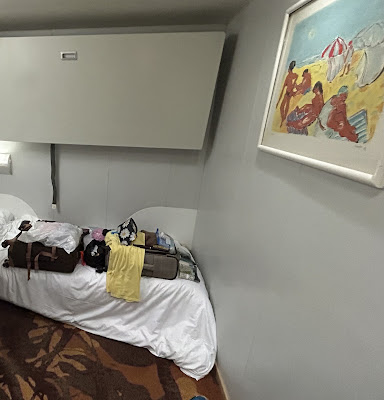

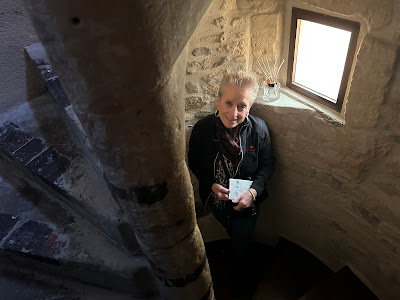



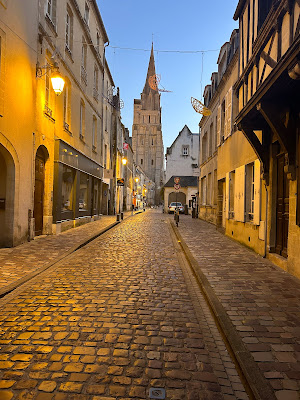








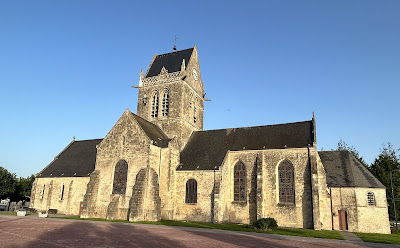


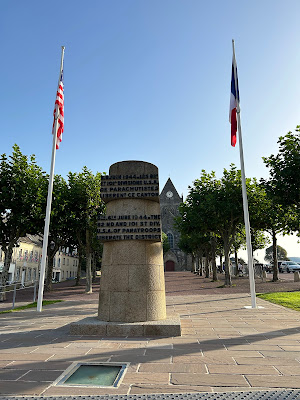



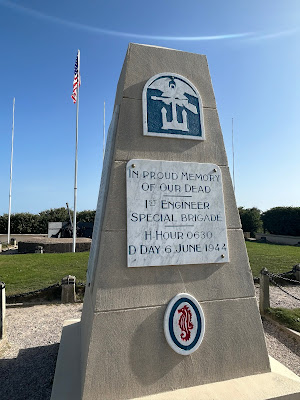





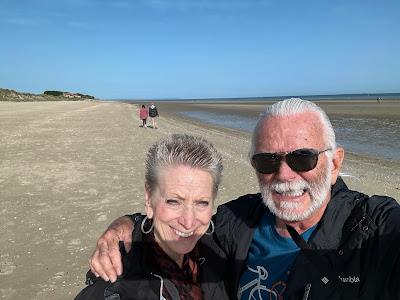












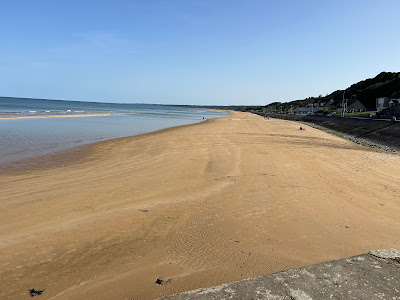

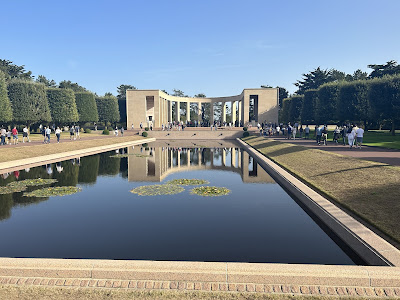

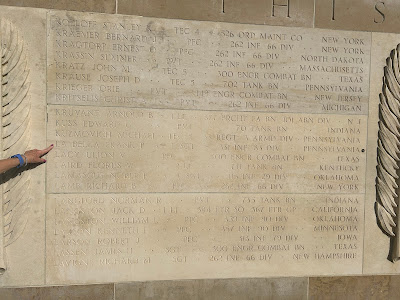



1 comment:
The Bayeux and The Landings at Normandy, what a moving post.... For me, this might be your best post ever! Thanks and Clear skies
Post a Comment